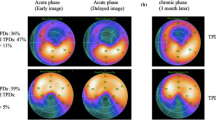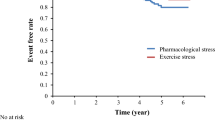Abstract
Uptake of thallium (Tl)-201 in the lungs has been proposed as a measure of left ventricular dysfunction. In this study we were interested in pursuing two goals: 1) to assess possible relationships between the post-exercise Tl-201 lung-heart (LH-) ratio determined from the anterior view during SPECT-acquisition, myocardial ischemia and the extent of coronary artery disease; and 2) to explore the effects of coronary revascularisation procedures on the LH-ratio. The study group consisted of 145 patients with early and late postexercise Tl-201 tomograms, including 32 PTCA-patients with pre- and post-PTCA studies and 20 patients who underwent coronary artery bypass surgery (CABG) with corresponding pre- and post-CABG studies. Ischemia was defined as evoked angina during the exercise test in combination with ≥1 mm horizontal or downsloping ST-depression on the ECG. The severity of coronary obstructions was assessed from coronary angiograms with a PC-based digital caliper technique; a stenosis was defined to be significant when its severity exceeded 50% diameter stenosis. The LH-ratio was defined by the ratio of the mean pulmonary counts and the mean myocardial counts assessed from corresponding regions of interest (ROI's) positioned over the left lung and the heart, respectively in the anterior view of a tomographic data acquisition procedure.
Our results made clear that the LH-ratio was not significantly different between patients with and without ischemia during exercise, and between patients with single vs. multiple vessel disease. However, the interventions had a significant effect of the LH-ratio:
LH-ratio mean ± s.d. | Pre-intervention | Post-intervention | p-value |
|---|---|---|---|
PTCA | 0.33 ± 0.10 | 0.28 ± 0.08 | < 0.01 |
CABG | 0.34 ± 0.11 | 0.29 ± 0.07 | < 0.01 |
In conclusion, the lung-heart ratio assessed from post-exercise Tl-201 tomograms is poorly correlated with myocardial ischemia and is not useful for the diagnosis of multiple CAD. However, the LH-ratio may be a useful complementary measurement in the serial assessment of patients undergoing revascularisation procedure.
Similar content being viewed by others
References
Baily IK, Griffith LSC, Rouleau J, Strauss HW, Pitt B. Thallium-201 myocardial perfusion imaging at rest and during exercise. Comparative sensitivity to electrocardiography in coronary artery disease. Circulation 1977; 55: 79.
Ritchie JL, Trobbaugh GB, Hamilton GW, Gould KL, Narahara K, Murray J, Williams D. Myocardial imaging with Thallium-201 at rest and during exercise: comparison with coronary arteriography and rest and exercise electrocardiography. Circulation 1977; 56: 66.
Hamilton GW, Trobaugh GB, Ritchie JL, Williams DL, Weaver WD, Gould KL. Myocardial imaging with intravenously injected thallium-201 in patients with suspected coronary artery disease: analysis or technique and correlation with electrocardiographic, coronary anatomic and ventriculographic findings. Am J Cardiol 1977; 39: 347.
Carillo AP, Marks DS, Packard SD, Khaja F, Goldstein S. Correlation of exercise 201-thallium myocardial scan with coronary arteriograms and the maximal exercise test. Chest 1978; 73: 321.
Botvinick EH, Taradesh MR, Shames DM, Parmley WW. Thallium-201 myocardial perfusion scintigraphy for the clinical classification of normal, abnormal and equivocal electrocardiographic stress tests. Am J Cardiol 1978; 44: 41.
Turner DA, Battle WE, Deshmukh H, Colandrea MA, Snyder GJ, Fordham EW, Messer JV. The predictive value of myocardial perfusion scintigraphy after stress in patients without previous myocardial infarction. J Nucl Med 1978; 19: 249.
Iskandrian AS, Wasserman LA, Anderson GS, Hakki A, Segal BC, Kane SA. Merits of stress thallium-201 myocardial perfusion imaging in patients with inconclusive exercise electrocardiograms: correlation with coronary angiograms. Am J Cardiol 1980; 46: 553.
Kaul S, Chesler DA, Okada RD, Boucher CA. Computer versus visual analysis of exercise thallium-201 images: a critical appraissalin 325 patients with chest pain. Am Heart J 1987; 114: 1129–37.
Ritchie JL, Williams DL, Harp G, Stratton JL, Caldwell JH. Transaxial tomography with thallium-201 for detecting remote myocardial infarction. Comparison with planar imaging. Am J Cardiol 1982; 50: 1236–41.
Maublant J, Cassagnes J, Lejeune JJ et al. A comparison between conventional scintigraphy and emission tomography with thallium-201 in detection of myocardial infarction: concise communication. J Nucl Med 1982; 23: 204–8.
Garcia EV, Van Train K, Maddahi J et al. Quantification of rotational thallium-201 myocardial tomography. J Nucl Med 1985; 26: 17–26.
Tamaki N, Yonekura Y, Mukai T et al. Stress thallium-201 transaxial emission computed tomography: quantitative versus qualitative analysis for evaluation of coronary artery disease. J Am Coll Cardiol 1984; 4: 1213–21.
Nohara R, Kambara H, Suzuki Y et al. Stress scintigraphy using single-photon emission tomography in the evaluation of coronary artery disease. Am J Cardiol 1984; 53: 1250–4.
Tamaki N, Yonekura Y, Mukai et al. Segmental analysis of stress thallium myocardial emission tomography for localization of coronary artery disease. Eur J Nucl Med 1984; 9: 99–105.
Fintel DJ, Links JM, Brinker JA, Frank TL, Becker LC. Comparison of tomographic and planar thallium imaging for identification of disease in individual coronary arteries (Abstract). Circulation 72 (suppl III): III-137.
Boucher CA, Zir LM, Beller GA et al. Increased lung uptake of thallium-201 during exercise myocardial imaging: clinical, hemodynamic and angiographic implications on patients with coronary artery disease. Am J Cardiol 1980; 46: 189–96.
Bingham JB, Mckusick KA, Strauss HW, Boucher CA, Pohost GM. Influence of coronary artery disease on pulmonary uptake of thallium-201. Am J Cardiol 1980; 46: 821–6.
Kushner FG, Okada RD, Kirstenbaum HD, Boucher CA, Strauss HW, Pohost GM. Lung thallium -201 uptake after stress testing in patients with coronary artery disease. Circulation 1981; 63: 341–7.
Homma S, Kaul S, Boucher SA. Correlates of lung/heart ratio of thallium-201 in coronary artery disease. J Nucl Med 1987; 28: 1531–5.
Gibson RS, Watson DD, Carabello BA, Holt ND, Beller GA. Clinical implications of increased lung uptake of thallium-201 during exercise scintigraphy 2 weeks after myocardial infarction. Am J Cardiol 1982; 49: 1586–93.
Tamaki N, Otoh H, Ishii Y et al. Hemodynamic significance of increased lung uptake of thallium-201. Am J Radiol 1982; 138: 223–8.
Wilson RA, Okada RD, Boucher CA et al. Radionuclidedetermined changes in blood volume and thallium lung uptake in patients with coronary artery disease. Am J Cardiol 1983; 51: 741–8.
Brown KA, Boucher CA, Okada RD et al. Quantification of pulmonary thallium-201 activity after upright exercise in normal persons: importance of peak heart rate and propanolol usage in defining normal values. Am J Cardiol 1984; 53: 1678–82.
Ilmer B, Reijs AEM, Fioretti P, Reiber JHC. Comparative study of three different approaches on the estimation of the lung-heart ratio in thallium-201 scintigrams in relation to the extent of coronary artery disease and left ventricular function (submitted for publication).
Kahn JK, Carry MM, McGhie I, Pippin JJ, Akers MS, Corbett JR. Quantitation of postexercise lung thallium-201 uptake during single photon emission computed tomography. J Nucl Med 1989; 30: 288–94.
Reiber JHC, Land CD von, Koning G, Loois G, Meurs B van. Advantages and limitations of two digital calipers in quantitative coronary arteriography (submitted for publication).
Levy R, Rozanski A, Berman DS et al. Analysis of the degree of pulmonary thallium washout after exercise in patients with coronary artery disease. J Am Coll Cardiol 1983; 2: 719–28.
Author information
Authors and Affiliations
Rights and permissions
About this article
Cite this article
Ilmer, B., Reijs, A.E.M., Reiber, J.H.C. et al. Relationships between the lung-heart ratio assessed from post-exercise thallium-201 myocardial tomograms, myocardial ischemia and the extent of coronary artery disease. Int J Cardiac Imag 6, 135–141 (1990). https://doi.org/10.1007/BF02398896
Issue Date:
DOI: https://doi.org/10.1007/BF02398896




